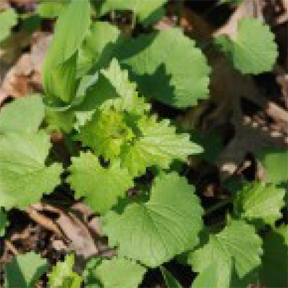Garlic mustard: Threat to woodlands
Garlic mustard threatens displacement of hundreds of native woodland plants and ferns.
In recent years, you may have heard about non-native plants that have become serious pests in nature such as purple loosestrife. Garlic mustard is yet another invader and it is rapidly becoming one of Michigan’s worst woodland weeds. Garlic mustard threatens displacement of hundreds of native woodland plants and ferns. It is a striking scene to see a forest woodlot that has been completely taken over by garlic mustard.
Why is garlic mustard so bad?
Settlers who proclaimed its medicinal properties and use it in cooking introduced this European native in North America. Like many non-native plants that reproduce by seed, garlic mustard escaped captivity of the settler’s gardens and is on the loose, rapidly dominating the forest floor. It will also invade the home landscape. Garlic mustard is a biennial – meaning it completes its lifecycle in just two years. The first year it is a diminutive, even attractive little plant with clusters of 3-4 rounded leaves with scalloped edges. These first-year plants remain green throughout the summer season and into late fall, making it easy to spot in the dormant season.
Garlic mustard is a biennial – meaning it completes its lifecycle in just two years. The first year it is a diminutive, even attractive little plant with clusters of 3-4 rounded leaves with scalloped edges. These first-year plants remain green throughout the summer season and into late fall, making it easy to spot in the dormant season.
This time of year second season garlic mustard plants grow robustly and will send up a flower stalk resulting in tiny white flower clusters that pollinate quickly becoming seeds within a few days after flowering begins. Flowering plants can reach 20-40 inches. Seeds mature and become viable in July and August when the plant dies. Second year garlic mustard leaf margins tend to become more toothed in nature than scalloped. Seed capsules are long and narrow, almost spikey-looking the way they stand right up on the end of the flower stalk.
How to control
Any control method selected must be repeated for several years until the residual seed from previous year’s plants has germinated. In my experience, small garlic mustard infestations can be controlled with a watchful eye and rigorous hand-pulling. Composting is not a good option as seeds can withstand the compost heating process and may not be destroyed.
Mowing or cutting has not proven to be the best solution. If you can cut the plants before the flower buds have opened this is the best option to avoid future seed production. Herbicides can be used in extreme cases, however, the delicate nature of the forest floor makes this not a very good option. Some states have treated severe infestations by spraying Glyphosate in October or early spring on the green plants. This technique will minimize the impact on non-target plant material that is dormant. As always, when choosing a pesticide to control a pest, read the label carefully and apply as directed.
Related Source:
Gardening in Michigan



 Print
Print Email
Email